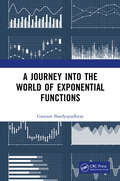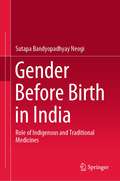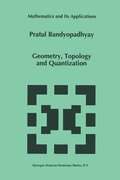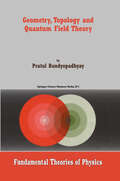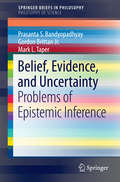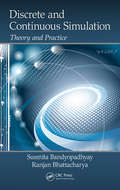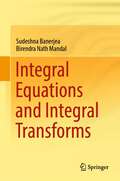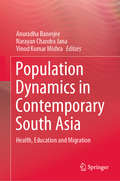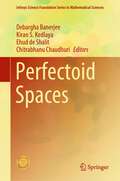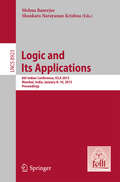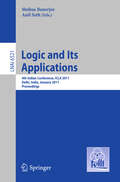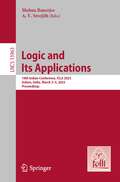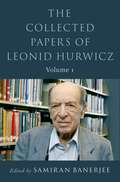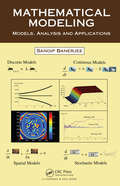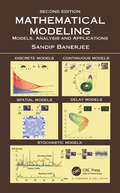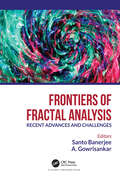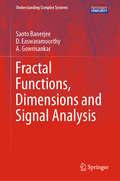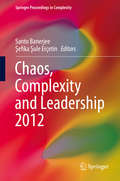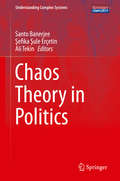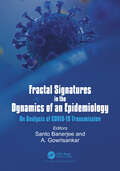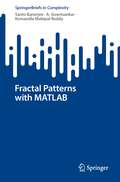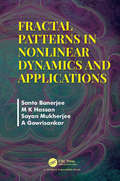- Table View
- List View
A Journey into the World of Exponential Functions
by Gautam BandyopadhyayThe number e, the function ex, the logarithmic function in (x) and different hyperbolic functions like cosh (x), sinh (x) make frequent appearances in science and engineering textbooks. Students often fail to appreciate the significance of these mathematical symbols. This book clearly illustrates why such abstract mathematical entities are needed to represent some aspects of physical reality. It provides an overview of different types of numbers and functions along with their historical background and applications. It contains four chapters covering number system, exponential function, logarithmic functions and hyperbolic functions along with the concept of complex angle. Print edition not for sale in South Asia (India, Sri Lanka, Nepal, Bangladesh, Pakistan or Bhutan)
Gender Before Birth in India: Role of Indigenous and Traditional Medicines
by Sutapa Bandyopadhyay NeogiThis book focuses on the role of the indigenous system of medicine or traditional medicines in gender selection in India. Issues such as the harmful effects of traditional practices on the health of the woman and the foetus during early pregnancy are explored in this book. It analyses the social and cultural practices and establishes linkages with modern methods of scientific investigations. It discusses how systematic exploration lends evidence of harmful traditional practices. The book is an important read for researchers, healthcare professionals and students in the field of medicine, public health and social sciences. It is an extremely valuable resource for all those engaged in research of traditional and modern systems of medicine.
Geometry, Topology and Quantization (Mathematics and Its Applications #386)
by P. BandyopadhyayThis is a monograph on geometrical and topological features which arise in various quantization procedures. Quantization schemes consider the feasibility of arriving at a quantum system from a classical one and these involve three major procedures viz. i) geometric quantization, ii) Klauder quantization, and iii) stochastic quanti zation. In geometric quantization we have to incorporate a hermitian line bundle to effectively generate the quantum Hamiltonian operator from a classical Hamil tonian. Klauder quantization also takes into account the role of the connection one-form along with coordinate independence. In stochastic quantization as pro posed by Nelson, Schrodinger equation is derived from Brownian motion processes; however, we have difficulty in its relativistic generalization. It has been pointed out by several authors that this may be circumvented by formulating a new geometry where Brownian motion proceses are considered in external as well as in internal space and, when the complexified space-time is considered, the usual path integral formulation is achieved. When this internal space variable is considered as a direc tion vector introducing an anisotropy in the internal space, we have the quantization of a Fermi field. This helps us to formulate a stochastic phase space formalism when the internal extension can be treated as a gauge theoretic extension. This suggests that massive fermions may be considered as Skyrme solitons. The nonrelativistic quantum mechanics is achieved in the sharp point limit.
Geometry, Topology and Quantum Field Theory (Fundamental Theories of Physics #130)
by P. BandyopadhyayThis is a monograph on geometrical and topological features which arise in quantum field theory. It is well known that when a chiral fermion interacts with a gauge field we have chiral anomaly which corresponds to the fact that divergence of the axial vector current does not vanish. It is observed that this is related to certain topological features associated with the fermion and leads to the realization of the topological origin of fermion number as well as the Berry phase. The role of gauge fields in the quantization procedure has its implications in these topological features of a fermion and helps us to consider a massive fermion as a soliton (skyrrnion). In this formalism chiral anomaly is found to be responsible for mass generation. This has its relevance in electroweak theory where it is observed that weak interaction gauge bosons attain mass topologically. The geometrical feature of a skyrmion also helps us to realize the internal symmetry of hadrons from reflection group. Finally it has been shown that noncommutative geometry where the space time manifold is taken to be X = M x Zz has its relevance in the description of a massive 4 fermion as a skyrmion when the discrete space is considered as the internal space and the symmetry breaking leads to chiral anomaly. In chap. l preliminary mathematical formulations related to the spinor structure have been discussed. In chap.
Belief, Evidence, and Uncertainty: Problems of Epistemic Inference (SpringerBriefs in Philosophy #0)
by Prasanta S. Bandyopadhyay Gordon Brittan Jr. Mark L. TaperThis work breaks new ground by carefully distinguishing the concepts of belief, confirmation, and evidence and then integrating them into a better understanding of personal and scientific epistemologies. It outlines a probabilistic framework in which subjective features of personal knowledge and objective features of public knowledge have their true place. It also discusses the bearings of some statistical theorems on both formal and traditional epistemologies while showing how some of the existing paradoxes in both can be resolved with the help of this framework.This book has two central aims: First, to make precise a distinction between the concepts of confirmation and evidence and to argue that failure to recognize this distinction is the source of certain otherwise intractable epistemological problems. The second goal is to demonstrate to philosophers the fundamental importance of statistical and probabilistic methods, at stake in the uncertain conditions in which for the most part we lead our lives, not simply to inferential practice in science, where they are now standard, but to epistemic inference in other contexts as well. Although the argument is rigorous, it is also accessible. No technical knowledge beyond the rudiments of probability theory, arithmetic, and algebra is presupposed, otherwise unfamiliar terms are always defined and a number of concrete examples are given. At the same time, fresh analyses are offered with a discussion of statistical and epistemic reasoning by philosophers. This book will also be of interest to scientists and statisticians looking for a larger view of their own inferential techniques.The book concludes with a technical appendix which introduces an evidential approach to multi-model inference as an alternative to Bayesian model averaging.
Discrete and Continuous Simulation: Theory and Practice
by Susmita Bandyopadhyay Ranjan BhattacharyaWhen it comes to discovering glitches inherent in complex systems-be it a railway or banking, chemical production, medical, manufacturing, or inventory control system-developing a simulation of a system can identify problems with less time, effort, and disruption than it would take to employ the original. Advantageous to both academic and industria
Integral Equations and Integral Transforms
by Sudeshna Banerjea Birendra Nath MandalThis comprehensive textbook on linear integral equations and integral transforms is aimed at senior undergraduate and graduate students of mathematics and physics. The book covers a range of topics including Volterra and Fredholm integral equations, the second kind of integral equations with symmetric kernels, eigenvalues and eigen functions, the Hilbert–Schmidt theorem, and the solution of Abel integral equations by using an elementary method. In addition, the book covers various integral transforms including Fourier, Laplace, Mellin, Hankel, and Z-transforms. One of the unique features of the book is a general method for the construction of various integral transforms and their inverses, which is based on the properties of delta function representation in terms of Green’s function of a Sturm–Liouville type ordinary differential equation and its applications to physical problems. The book is divided into two parts: integral equations and integral transforms. Each chapter is supplemented with numerous illustrative examples to aid in understanding. The clear and concise presentation of the topics covered makes this book an ideal resource for students, researchers, and professionals interested in the theory and application of linear integral equations and integral transforms.
Population Dynamics in Contemporary South Asia: Health, Education and Migration
by Anuradha Banerjee Narayan Chandra Jana Vinod Kumar MishraThis book discusses the sequential development of population research in India, focusing on contemporary issues like demography, population studies, geography, sociology, urban studies and many more. It describes the problems related to the underdeveloped regions in India, Nepal and Bangladesh and includes tabular representations of the analyzed data as well as visual representations/illustrations in the form of graphs and maps. Further, it features fascinating case studies on primary field-research experiences. Presenting interdisciplinary contributions, the book is divided into four sections: the first part examines social issues related to health, while the second explores social sustainability, lifestyles, and cultural aspects. The third and fourth sections address migration and quality of life, respectively. The book is of interest to students studying demography, as well as researchers and policymakers in the fields of population studies, geography and sociology.
Perfectoid Spaces: Lectures From The 2017 Arizona Winter School (Infosys Science Foundation Series)
by Debargha Banerjee Kiran S. Kedlaya Ehud De Shalit Chitrabhanu ChaudhuriThis book contains selected chapters on perfectoid spaces, their introduction and applications, as invented by Peter Scholze in his Fields Medal winning work. These contributions are presented at the conference on “Perfectoid Spaces” held at the International Centre for Theoretical Sciences, Bengaluru, India, from 9–20 September 2019. The objective of the book is to give an advanced introduction to Scholze’s theory and understand the relation between perfectoid spaces and some aspects of arithmetic of modular (or, more generally, automorphic) forms such as representations mod p, lifting of modular forms, completed cohomology, local Langlands program, and special values of L-functions. All chapters are contributed by experts in the area of arithmetic geometry that will facilitate future research in the direction.
Logic and Its Applications: 6th Indian Conference, ICLA 2015, Mumbai, India, January 8-10, 2015. Proceedings (Lecture Notes in Computer Science #8923)
by Mohua Banerjee Krishna S.This book collects the refereed proceedings of the 6th Indian Conference on Logic and Its Applications, ICLA 2015, held in Mumbai, India, in January 2015. The volume contains 13 full revised papers along with 3 invited talks presented at the conference. The papers were selected after rigorous review, from 23 submissions. They cover topics related to pure and applied formal logic, foundations and philosophy of mathematics and the sciences, set theory, model theory, proof theory, areas of theoretical computer science, artificial intelligence, systems of logic in the Indian tradition, and other disciplines which are of direct interest to mathematical and philosophical logic.
Logic and Its Applications: Fourth Indian Conference, ICLA 2011, Delhi, India, January 5-11, 2011, Proceedings (Lecture Notes in Computer Science #6521)
by Mohua Banerjee Anil SethEdited in collaboration with FoLLI, the Association of Logic, Language and Information, this book constitutes the refereed proceedings of the 4th Indian Conference on Logic and Its Applications, ICLA 2011, held in Delhi, India, in January 2011. The 14 revised full papers presented together with 3 invited talks were carefully reviewed and selected from 34 submissions. The papers present current research in all aspects of formal logic ranging from pure and applied logic to history of logic.
Logic and Its Applications: 10th Indian Conference, ICLA 2023, Indore, India, March 3–5, 2023, Proceedings (Lecture Notes in Computer Science #13963)
by Mohua Banerjee A. V. SreejithEdited in collaboration with FoLLI, this book constitutes the refereed proceedings of the 10th Indian Conference on Logic and Its Applications, ICLA 2023, which was held in Indore, India, in March 2023.Besides 6 invited papers presented in this volume, there are 9 contributed full papers which were carefully reviewed and selected from 18 submissions. The volume covers a wide range of topics. These topics are related to modal and temporal logics, intuitionistic connexive and imperative logics, systems for reasoning with vagueness and rough concepts, topological quasi-Boolean logic and quasi-Boolean based rough set models, and first-order definability of path functions of graphs.
The Collected Papers of Leonid Hurwicz: Volume 1
by Samiran BanerjeeLeonid Hurwicz (1917-2008) was a major figure in modern theoretical economics whose contributions over sixty-five years spanned at least five areas: econometrics, nonlinear programming, decision theory, microeconomic theory, and mechanism design. In 2007, at age ninety, he received the Nobel Memorial Prize in Economics (shared with Eric Maskin and Roger Myerson) for pioneering the field of mechanism design and incentive compatibility. Hurwicz made seminal contributions in the other areas as well. In non-linear programming, he contributed to the understanding of Lagrange-Kuhn-Tucker problems (along with co-authors Kenneth Arrowand Hirofumi Uzawa). In econometrics, the Hurwicz bias in the least-squares analysis of time series is a fundamental and commonly cited benchmark. In decision theory, the Hurwicz criterion for decision-making under ambiguity is routinely invoked, sometimes without a citation since his original paper was never published. In microeconomic theory, Hurwicz (along with Arrow and H.D. Block) initiated the study of stability of the market mechanism, and (with Uzawa) solved the classic integrability of demand problem, a core result in neoclassical consumer theory. While some of Hurwicz's work were published in journals, many remain scattered as chapters in books which are difficult to access; yet others were never published at all. The Collected Papers of Leonid Hurwicz is the first volume in a series of four that will bring his oeuvre in one place, to bring to light the totality of his intellectual output, to document his contribution to economics and the extent of his legacy, with the express purpose to make it easily available for future generations of researchers to build upon.
The Collected Papers of Leonid Hurwicz: Volume 1
by Samiran BanerjeeLeonid Hurwicz (1917-2008) was a major figure in modern theoretical economics whose contributions over sixty-five years spanned at least five areas: econometrics, nonlinear programming, decision theory, microeconomic theory, and mechanism design. In 2007, at age ninety, he received the Nobel Memorial Prize in Economics (shared with Eric Maskin and Roger Myerson) for pioneering the field of mechanism design and incentive compatibility. Hurwicz made seminal contributions in the other areas as well. In non-linear programming, he contributed to the understanding of Lagrange-Kuhn-Tucker problems (along with co-authors Kenneth Arrowand Hirofumi Uzawa). In econometrics, the Hurwicz bias in the least-squares analysis of time series is a fundamental and commonly cited benchmark. In decision theory, the Hurwicz criterion for decision-making under ambiguity is routinely invoked, sometimes without a citation since his original paper was never published. In microeconomic theory, Hurwicz (along with Arrow and H.D. Block) initiated the study of stability of the market mechanism, and (with Uzawa) solved the classic integrability of demand problem, a core result in neoclassical consumer theory. While some of Hurwicz's work were published in journals, many remain scattered as chapters in books which are difficult to access; yet others were never published at all. The Collected Papers of Leonid Hurwicz is the first volume in a series of four that will bring his oeuvre in one place, to bring to light the totality of his intellectual output, to document his contribution to economics and the extent of his legacy, with the express purpose to make it easily available for future generations of researchers to build upon.
Mathematical Modeling: Models, Analysis and Applications
by Sandip BanerjeeAlmost every year, a new book on mathematical modeling is published, so, why another? The answer springs directly from the fact that it is very rare to find a book that covers modeling with all types of differential equations in one volume. Until now. Mathematical Modeling: Models, Analysis and Applications covers modeling with all kinds of differe
Mathematical Modeling: Models, Analysis and Applications
by Sandip BanerjeeMathematical Modeling: Models, Analysis and Applications, Second Edition introduces models of both discrete and continuous systems. This book is aimed at newcomers who desires to learn mathematical modeling, especially students taking a first course in the subject. Beginning with the step-by-step guidance of model formulation, this book equips the reader about modeling with difference equations (discrete models), ODE’s, PDE’s, delay and stochastic differential equations (continuous models). This book provides interdisciplinary and integrative overview of mathematical modeling, making it a complete textbook for a wide audience. A unique feature of the book is the breadth of coverage of different examples on mathematical modelling, which include population models, economic models, arms race models, combat models, learning model, alcohol dynamics model, carbon dating, drug distribution models, mechanical oscillation models, epidemic models, tumor models, traffic flow models, crime flow models, spatial models, football team performance model, breathing model, two neuron system model, zombie model and model on love affairs. Common themes such as equilibrium points, stability, phase plane analysis, bifurcations, limit cycles, period doubling and chaos run through several chapters and their interpretations in the context of the model have been highlighted. In chapter 3, a section on estimation of system parameters with real life data for model validation has also been discussed. Features Covers discrete, continuous, spatial, delayed and stochastic models. Over 250 illustrations, 300 examples and exercises with complete solutions. Incorporates MATHEMATICA® and MATLAB®, each chapter contains Mathematica and Matlab codes used to display numerical results (available at CRC website). Separate sections for Projects. Several exercise problems can also be used for projects. Presents real life examples of discrete and continuous scenarios. The book is ideal for an introductory course for undergraduate and graduate students, engineers, applied mathematicians and researchers working in various areas of natural and applied sciences.
Mathematical Modeling: Models, Analysis and Applications
by Sandip BanerjeeMathematical Modeling: Models, Analysis and Applications, Second Edition introduces models of both discrete and continuous systems. This book is aimed at newcomers who desires to learn mathematical modeling, especially students taking a first course in the subject. Beginning with the step-by-step guidance of model formulation, this book equips the reader about modeling with difference equations (discrete models), ODE’s, PDE’s, delay and stochastic differential equations (continuous models). This book provides interdisciplinary and integrative overview of mathematical modeling, making it a complete textbook for a wide audience. A unique feature of the book is the breadth of coverage of different examples on mathematical modelling, which include population models, economic models, arms race models, combat models, learning model, alcohol dynamics model, carbon dating, drug distribution models, mechanical oscillation models, epidemic models, tumor models, traffic flow models, crime flow models, spatial models, football team performance model, breathing model, two neuron system model, zombie model and model on love affairs. Common themes such as equilibrium points, stability, phase plane analysis, bifurcations, limit cycles, period doubling and chaos run through several chapters and their interpretations in the context of the model have been highlighted. In chapter 3, a section on estimation of system parameters with real life data for model validation has also been discussed. Features Covers discrete, continuous, spatial, delayed and stochastic models. Over 250 illustrations, 300 examples and exercises with complete solutions. Incorporates MATHEMATICA® and MATLAB®, each chapter contains Mathematica and Matlab codes used to display numerical results (available at CRC website). Separate sections for Projects. Several exercise problems can also be used for projects. Presents real life examples of discrete and continuous scenarios. The book is ideal for an introductory course for undergraduate and graduate students, engineers, applied mathematicians and researchers working in various areas of natural and applied sciences.
Frontiers of Fractal Analysis: Recent Advances and Challenges
by Santo BanerjeeThe history of describing natural objects using geometry is as old as the advent of science itself, in which traditional shapes are the basis of our intuitive understanding of geometry. However, nature is not restricted to such Euclidean objects which are only characterized typically by integer dimensions. Hence, the conventional geometric approach cannot meet the requirements of solving or analysing nonlinear problems which are related with natural phenomena, therefore, the fractal theory has been born, which aims to understand complexity and provide an innovative way to recognize irregularity and complex systems. Although the concepts of fractal geometry have found wide applications in many forefront areas of science, engineering and societal issues, they also have interesting implications of a more practical nature for the older classical areas of science. Since its discovery, there has been a surge of research activities in using this powerful concept in almost every branch of scientific disciplines to gain deep insights into many unresolved problems. This book includes eight chapters which focus on gathering cutting-edge research and proposing application of fractals features in both traditional scientific disciplines and in applied fields.
Fractal Functions, Dimensions and Signal Analysis (Understanding Complex Systems)
by Santo Banerjee D. Easwaramoorthy A. GowrisankarThis book introduces the fractal interpolation functions (FIFs) in approximation theory to the readers and the concerned researchers in advanced level. FIFs can be used to precisely reconstruct the naturally occurring functions when compared with the classical interpolants. The book focuses on the construction of fractals in metric space through various iterated function systems. It begins by providing the Mathematical background behind the fractal interpolation functions with its graphical representations and then introduces the fractional integral and fractional derivative on fractal functions in various scenarios. Further, the existence of the fractal interpolation function with the countable iterated function system is demonstrated by taking suitable monotone and bounded sequences. It also covers the dimension of fractal functions and investigates the relationship between the fractal dimension and the fractional order of fractal interpolation functions. Moreover, this book explores the idea of fractal interpolation in the reconstruction scheme of illustrative waveforms and discusses the problems of identification of the characterizing parameters. In the application section, this research compendium addresses the signal processing and its Mathematical methodologies. A wavelet-based denoising method for the recovery of electroencephalogram (EEG) signals contaminated by nonstationary noises is presented, and the author investigates the recognition of healthy, epileptic EEG and cardiac ECG signals using multifractal measures. This book is intended for professionals in the field of Mathematics, Physics and Computer Science, helping them broaden their understanding of fractal functions and dimensions, while also providing the illustrative experimental applications for researchers in biomedicine and neuroscience.
Chaos, Complexity and Leadership 2012 (Springer Proceedings in Complexity)
by Santo Banerjee Şefika Şule ErçetinThese proceedings from the 2012 symposium on "Chaos, complexity and leadership" reflect current research results from all branches of Chaos, Complex Systems and their applications in Management. Included are the diverse results in the fields of applied nonlinear methods, modeling of data and simulations, as well as theoretical achievements of Chaos and Complex Systems. Also highlighted are Leadership and Management applications of Chaos and Complexity Theory.
Chaos Theory in Politics (Understanding Complex Systems)
by Santo Banerjee Şefika Şule Erçetin Ali TekinThe present work investigates global politics and political implications of social science and management with the aid of the latest complexity and chaos theories. Until now, deterministic chaos and nonlinear analysis have not been a focal point in this area of research. This book remedies this deficiency by utilizing these methods in the analysis of the subject matter. The authors provide the reader a detailed analysis on politics and its associated applications with the help of chaos theory, in a single edited volume.
Fractal Signatures in the Dynamics of an Epidemiology: An Analysis of COVID-19 Transmission
by Santo Banerjee A. GowrisankarThe recent Covid-19 pandemic threw the world into complete chaos with its rapid and devastating spread. Scientists are still trying to obtain a better understanding of the patterns of COVID-19 and trying to get a deeper understanding of mutant strains and their pathogenicity by performing genomic sequences of more samples. Fractal-based analysis provides its unique forecasting policy to reduce the spread of COVID-19, and in general, of any outbreaks. The book presents fractal and multifractal models of COVID-19 and reviews the impact of the pandemic including epidemiology, genome organization, transmission cycle, and control strategies based on mathematical models towards developing an immune intervention. Also, it covers non-clinical aspects such as economic development with graphical illustrations, meeting the needs of onlookers outside the sector who desire additional information on the epidemic. The fractal signatures describe the fractal textures in the patterns of Corona virus. Studies on the epidemiology of Covid-19 in relation with the fractals and fractal functions serve to exhibit its irregular chaotic nature. Moreover, the book with its wide coverage on the Hurst exponent analysis and the fractal dimension estimation, greatly aids in measuring the epidemiology.
Frontiers of Fractal Analysis: Recent Advances and Challenges
by Santo Banerjee A. GowrisankarThe history of describing natural objects using geometry is as old as the advent of science itself, in which traditional shapes are the basis of our intuitive understanding of geometry. However, nature is not restricted to such Euclidean objects which are only characterized typically by integer dimensions. Hence, the conventional geometric approach cannot meet the requirements of solving or analysing nonlinear problems which are related with natural phenomena, therefore, the fractal theory has been born, which aims to understand complexity and provide an innovative way to recognize irregularity and complex systems. Although the concepts of fractal geometry have found wide applications in many forefront areas of science, engineering and societal issues, they also have interesting implications of a more practical nature for the older classical areas of science. Since its discovery, there has been a surge of research activities in using this powerful concept in almost every branch of scientific disciplines to gain deep insights into many unresolved problems. This book includes eight chapters which focus on gathering cutting-edge research and proposing application of fractals features in both traditional scientific disciplines and in applied fields.
Fractal Patterns with MATLAB (SpringerBriefs in Complexity)
by Santo Banerjee A. Gowrisankar Komandla Mahipal ReddyThis book presents the iterative beauty of fractals and fractal functions graphically with the aid of MATLAB programming. The fractal images generated using the MATLAB codes provide visual delight and highly encourage the fractal lovers for creative thinking. The book compiles five cutting-edge research chapters, each with state-of-the art fractal illustrations. It starts with the fundamental theory for the construction of fractal sets via the deterministic iteration algorithm. Incorporating the theoretical base, fractal illustrations of elementary fractal sets are provided with the explicit MATLAB code. The book gives examples of MATLAB codes to present the fractal surfaces. This book is contributed to all the research beginners as well as the professionals on the field of fractal analysis. As it covers basic fractals like Sierpinski triangle to advanced fractal functions with explicit MATLAB code, the presented fractal illustrations hopefully benefit even the non-field readers. The book is a useful course to all the research beginners on the fractal and fractal-related fields.
Fractal Patterns in Nonlinear Dynamics and Applications: Patterns in Nonlinear Dynamics and Applications
by Santo Banerjee M K Hassan Sayan Mukherjee A GowrisankarMost books on fractals focus on deterministic fractals as the impact of incorporating randomness and time is almost absent. Further, most review fractals without explaining what scaling and self-similarity means. This book introduces the idea of scaling, self-similarity, scale-invariance and their role in the dimensional analysis. For the first time, fractals emphasizing mostly on stochastic fractal, and multifractals which evolves with time instead of scale-free self-similarity, are discussed. Moreover, it looks at power laws and dynamic scaling laws in some detail and provides an overview of modern statistical tools for calculating fractal dimension and multifractal spectrum.
